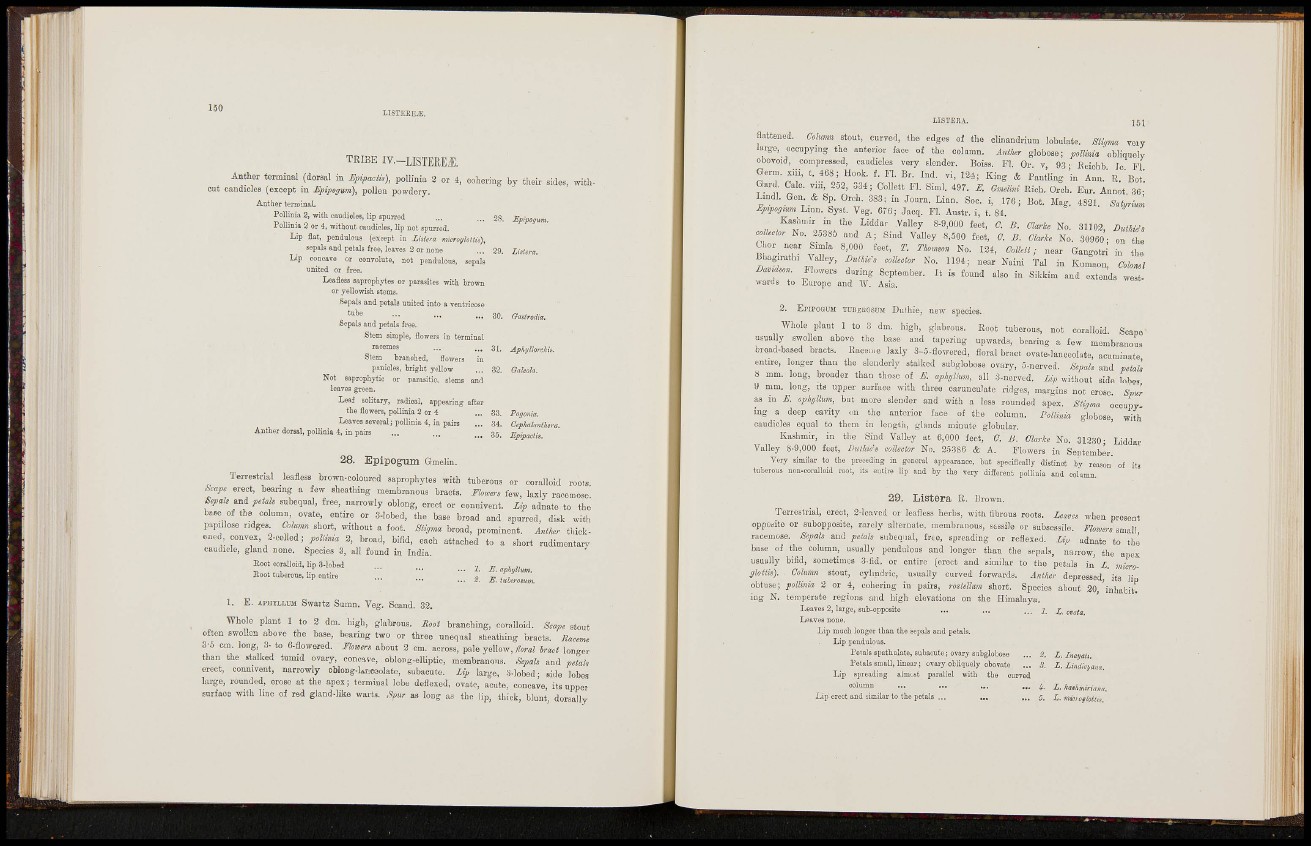
Aphyllorchh.
Galeoìa.
TRIBE IV.-LISTERE/E.
Anther terminal (dorsal in Epipaciis), pollinia 3 or 4, cohering by tlaeir sides, withcut
candiclcs (except in Epipogum), pollen powdery.
Anther termiaaL
Po]linia 2, with caudiolea, lip spun-ed ... ... gg Epipogum
Pollinia 2 or 4, without oaudicles, Hp not spurred.
Lip flat, pendulous (except in Listera mierogloiti»),
sepals and petals free, leaves 2 or none ... 29. Listera.
Lip concave or convolute, not pendulous, sepals
united or free.
Leafless saprophytes or parasites -with brown
or yellovfiah stems.
Sepals and petals united into a ventrioose
^ - ••• ... 80. Gaiirodia.
Sepals and petals free.
Stem simple, flowers in terminal
racemes
Stem branched, flowers in
panicles, bright yellow
Not saprophytic or parasitic, stems and
leaves green.
Leaf solitary, radical, appearing after
the flowers, poUinia 2 or 4 ... -33. Pogonia.
Leaves several; poUinia 4, in pairs ... 34. Cephalantlma.
Anther dorsal, pollinia 4, in pairs ... 35. Epipacth.
28. Epipogum Gmelin.
Terrestrial M e s . brown-oolourad saprophytes with tuberous or coralloid root,
Bcafe ereot, bearmg a iew sheatMng membranous bracts. F h « m few, k j l y lanemose
. n d f M , subequal, free, uarrowly oblong, erect or connivent. & adnate to the
b . , e of the column, „™te, entire or 3-lobed, the ba,e broad and spurred, disk ^vith
papulose r.dge. Column short, without a foet. Stigm. broad, prominent. Mkr thick,
oned conT», 2-celled; polimia 2, broad, bifid, each attached to a short rudimentary
caudicle, gland none. Species 3, all found in India.
Root coraUoid, lip 3-lobed p , „
iioot tuberous,' bpf entire" ... ... ... „g . En . .i ul,e >-omm.
1. E. APHYLLUji Swaitz Sumn. Veg. Scand. 32,
Whole plant 1 to 3 dm. high, glabrous. Boot branching, coralloid. Scape stout
often swollen above the base, bearing two or three unequal sheathing bracts. R „ e „,
3-6 cm. long, 3- to 6-floweied. Ihwers about 2 cm. across, pale yellow, floral hract longer
than the stalked tumid oyary, concave, oblong-elhptic, membranous. Sepah and petal,
erect, connivent, narrowly clilong-Ui.<!oolato, «ubaouto. Lip large, 3-lobed; side lobes
large, rounded, erose at the a p e s j terminal lobe deilexed, ovate, acute, concare, its upper
surface with lino of ted gland-like warts. Smr as long as the lip, thick, blunt dorsally
LISTERA. 151
flattened. Column stout, currod, the edges of the clinandrium lobulate, mùjna veiy
large, occupying the anterior face of tho eoliimn. Antlm- globose; poUmm obliquely
ohoToid, compressed, caudicles very slender. Boias. Fl, Or. v, 93- Eeichb Jc Fl
Germ. ,Iii, t. 468; Hook, f. Fl. Br. Ind. ri, 184; King 4 Fantling in A n n . ' R . 'Bot'.
Gar, . Calo, yiii 252, =34; Collett Fl. Siml. 497. Ä ft* Eich. Orch. Eur. Annot. 36-
Liudl. Qen & Sp. Orch. 383, in Jonrn. Linn. Soc. i, 176; Bot. Mag. 4S21,
Jip.pof,«^ Linn. Syst. Veg. 67(1; Jacq. Fl. Austr. i, t. 84.
K a j i m r in the Lidda,- Valley 8-9,000 feet, a B. Clark, No. 31102, DuUm',
oomor Ho. 25385 and A; Sind Valley ,S,500 feel, C. ClurU No. 30960 • on he
C , o , near Simla 8,000 feet, T. Thom.o. No. 134, Collett; near Gangotri in the
Damd.0,. Flowers during September. It is found also in Sikkim and extends westwards
to Europe and W. Asia.
2. Epipogum teibekosusì Duthie, new species.
Whole plant 1 to 3 dm. high, glabrous. Root tuberous, not coralloid Scape
usually swollen above the base and tapering upwards, bearing a few membranous
broad-based bracts. Eaceine laxly 3-5-flowered, floral bract ovate-lanceolate, acuminate
entire, longer than the slenderly stalked subglobose ovary, 5-nerved. Sepuh and petab
» mm. long, broader than those of E. aph,llum, all 3-nerved. Up without side lobe.
9 mm. long, its upper surface with three carunculate ridges, margins not erose. Spilr
as in K ophi/Uum, but more slender and with a less rounded apex,
ing a deep cavity „n tho anterior face of the column. Pollinia
caudicles equal to them in length, glands minute globular.
Kashmir, in the Sind Valley at 6,000 feet, C. B. Clarke No. 31230- Liddar
Valley S-9,000 feet, UulhJs collector No. 25388 & A. Flowers in Sentcmb¡r.
Very similat to tie preceding in general uppemaee, bat .pecietally distinot b, reuon of it,
lol.roiis uon-toralloid root, it. eutir. Hp and by tile very diSereat pollinia ind column.
OCCupy-
With
29. Listera H. Brown.
Terrestrial, erect, 2-leaved or leafless herbs, with fibrous roots. Leaves when present
opposite or subopposite, rarely alternate, membranous, sessile or subsessile. Flowers small
racemose. Sepals and petals subeqiial, free, spreading or reileied. Lip adnaie to the
base of the column, usually pendulous and longer than the sepals, narrow, the apex
usually bifid, sometimes 3-fid. or entire (erect and similar to the petals in L. mierogbtiis).
Cohmii stout, cylmdric, usually curved forwards. Anther depressed its lip
obtuse; pollima 2 or 4, cohering in pairs, rosletUm short. Species about 20, 'inhabit.
ing N. temperate regions and high elevations on
Leaves 2, large, sub.opposite
Leaves none.
Lip much longer than the sepals and petals.
Lip pendulous.
Petals spatliulate, subacute; ovary
Petals small, hnear; ovary obliquely obovnte
Lip spreading ahuost parallel with the c;
oolumu
Lip erect aud similar to the petals ...
Himalaya.
á. L. Inayati.
3. L, Lindw^ann,
k. L. koBkmirtann,
5. L. Mtieioslùitìì,